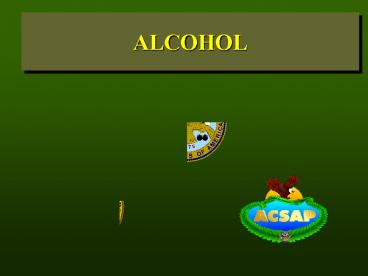ALCOHOL - PowerPoint PPT Presentation
1 / 14
Title:
ALCOHOL
Description:
EFFECTS OF ALCOHOL AND BAC ... Damage Sexual Impotence Liver Cirrhosis/Cancer Death Pregnancy Complications 2000 National Household Survey on Drug Abuse ... – PowerPoint PPT presentation
Number of Views:223
Avg rating:3.0/5.0
Title: ALCOHOL
1
ALCOHOL
2
- WHAT IS ALCOHOL?
- Alcohol is the MOST ABUSED drug by Soldiers.
- Alcohol is a colorless and pungent liquid that
can be - found in beverages such as wine, beer, and
liquor. - Alcohol is a Central Nervous System (CNS)
depressant. - Alcohol is considered to be a gateway drug to
other drug use. - People who drink alcohol are more prone to
divorce and suicide than the rest of the
population.
3
- WHAT IS ALCOHOL?
- A standard alcohol drink is considered to be
- One 12-ounce bottle of beer
- One 5-ounce glass of wine
- 1.5 ounces of 80-proof distilled spirits.
- Alcohol is also known as
- Booze
- Juice
- Sauce
- Grog
- Piss
4
- WHAT IS BLOOD ALCOHOL CONTENT (BAC)?
- Blood Alcohol Content (BAC) - The amount of
alcohol present in a 100 milliliter (mL) volume
of blood. - The BAC is related to the users
- Body Weight
- Metabolism
- Drinking Speed Someone that chugs their
drink will have a higher BAC than someone that
sips the same amount of alcohol.
5
- EFFECTS OF ALCOHOL AND BAC
.02 - .03 BAC No loss of coordination, slight
euphoria and loss of shyness. Depressant
effects are not apparent. .04 - .06 BAC
Feeling of well-being, relaxation, euphoria, and
lower inhibitions. Minor impairment of
reasoning and memory. .05 IS THE LEGAL
LIMIT IN THE U.S. ARMY. .07 - .09 BAC
Slight impairment of balance, speech, vision,
and reaction time. Judgment and
self-control are reduced, caution and
reason are impaired. IN MOST STATES THE
LEGAL LIMIT IS .08. .1 - .125 BAC Significant
impairment of motor coordination and loss of good
judgment. Speech is slurred and balance,
vision, reaction time, and hearing are impaired.
IT IS ILLEGAL IN ALL STATES TO OPERATE A MOTOR
VEHICLE AT THIS STAGE.
6
- EFFECTS OF ALCOHOL AND BAC
.13 - .15 BAC - Gross motor impairment and lack
of physical control. Blurred vision and
serious loss of balance. Euphoria is reduced and
dysphoria (anxiety, restlessness) begins to
appear. .16 - .20 BAC Dysphoria predominates,
nausea begins to appear. The drinker appears
to be a sloppy drunk. .25 BAC - Needs
assistance in walking total mental confusion.
Dysphoria with nausea and some vomiting. .30
BAC - Loss of consciousness. .40 BAC
- Coma, and possible death due to
respiratory arrest.
7
IMMEDIATE PHYSICAL EFFECTS
- Slurred Speech
- Staggering
- Nausea/Vomiting
- Slow Reactions
- Impaired Motor Skills
- Irregular Pulse
- Blurred Vision
- Enlarged Heart
- High Blood Pressure
- Loss of Inhibitions
- Unconsciousness
- Dizziness
8
PHYSICAL SIGNS OF USE
- Nausea/Vomiting
- Dizziness
- Dilated Pupils
- Slow Reactions
- Slurred Speech
- Irregular Pulse
- Blurred Vision
- Enlarged Heart
- High Blood Pressure
- Alcohol Odor on Breath
- Unconsciousness
- Overdose/Death
9
LONG TERM EFFECTS
- Vitamin Deficiencies
- Pregnancy Complications
- Skin Problems
- Liver Cirrhosis/Cancer
- Heart Disorders
- Loss of Muscle Tissue
- Blood Disorders
- Sexual Impotence
- Lung Disease
- Stomach Damage
- Brain Damage
- Small Intestine Damage
- Loss of Feeling in Hands/Feet
- Death
10
ALCOHOL WITHDRAWAL
- When a alcohol dependent person stops consuming
alcohol they may experience withdrawal symptoms - Auditory Hallucinations
- Paranoid Behavior
- Body Trembles, The Shakes, this can occur as
early as 12 hours after the last drink. - The alcohol dependent person may also show minor
signs of withdrawal - Agitation
- Profuse Sweating
- Nausea/Vomiting
- Incoherent Speech
11
ALCOHOL WITHDRAWAL
- The addicted individual can also suffer extremely
serious, and sometimes fatal, side effects of
alcohol withdrawal - Delirium Tremens (DTs) - A disorder involving
sudden and severe mental changes (psychosis) or
neurologic changes (including seizures) caused by
stopping the use of alcohol. - Alcoholic Psychoses, when the addicted person is
scared of imaginary small animals, and horrible
sights and sounds.
12
ALCOHOL USE IN THE UNITED STATES
Percentages Reporting Past Month Alcohol Use,
Past Month "Binge" Alcohol Use, and Past Month
Heavy Alcohol Use Among Persons Aged 18-25, 1999
and 2000
2000 National Household Survey on Drug Abuse
13
ADDITIONAL RESOURCES
- http//www.erowid.org/chemicals/alcohol/alcohol.sh
tml - http//www.niaaa.nih.gov/
- http//www.health.org
- http//www.sayno.com/alcohol.html
- http//www.alcoholics-anonymous.org/
- http//www.al-anon.alateen.org/
14
UNITED STATESARMY CENTER FOR SUBSTANCE ABUSE
PROGRAMS
For more Information Contact ACSAP E-mail
upl.acsap_at_usadaoa-emh1.army.mil































